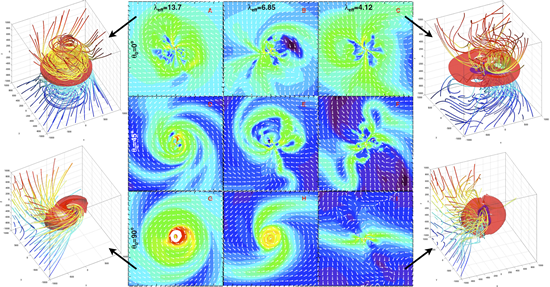Disk Formation Enabled by Misalignment between Magnetic Fields and Rotation Axis

Snapshots of 2D density distributions of models A to I. From top to bottom, the angle of magnetic field and rotational axis changes from aligned to totally misaligned. From left to right, the magnetic field strength increased by lowering the effective mass-to-flux ratio. The 3D density and field line distributions show examples of different extents of misalignment and mass-to-flux ratios.
Stars form in dense cores of molecular clouds that are observed to be significantly magnetized. In the simplest case of a laminar (non-turbulent) core with the magnetic field aligned with the rotation axis, both analytic considerations and numerical simulations have shown that the formation of a large, 102-AU scale, rotationally supported protostellar disk is suppressed by magnetic braking in the ideal MHD limit for a realistic level of core magnetization. This theoretical difficulty in forming protostellar disks is termed the “magnetic braking catastrophe.” A possible resolution to this problem is that misalignment between the magnetic field and rotation axis may weaken the magnetic braking enough to enable disk formation. We evaluate this possibility quantitatively through numerical simulations and confirm the basic result of Joos et al. that the misalignment is indeed conducive to disk formation. In relatively weakly magnetized cores with dimensionless mass-to-flux ratio ~4, it enabled the formation of rotationally supported disks that would otherwise be suppressed if the magnetic field and rotation axis are aligned. For more strongly magnetized cores, disk formation remains suppressed, however, even for the maximum tilt angle of 90°. If dense cores are as strongly magnetized as indicated by OH Zeeman observations (with a mean dimensionless mass-to-flux ratio ~2), it would be difficult for the misalignment alone to enable disk formation in the majority of them. We conclude that, while beneficial to disk formation, especially for the relatively weak field case, misalignment does not completely solve the problem of catastrophic magnetic braking in general. (Li, Krasnopolsky, & Shang 2013 ApJ, 774, 82)